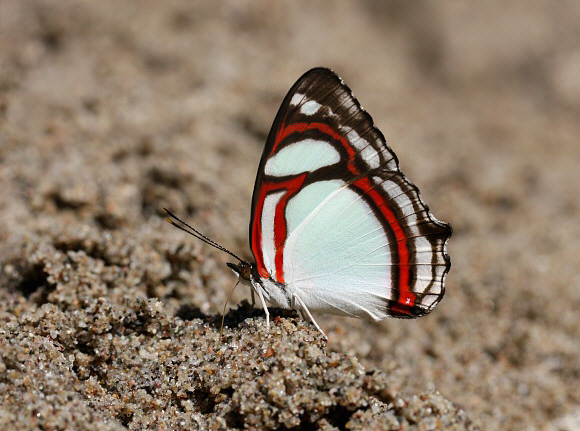 Pyrrhogyra otolais, Rio Pindayo, Peru – Adrian Hoskins
Pyrrhogyra otolais, Rio Pindayo, Peru – Adrian Hoskins
Introduction
The genus Pyrrhogyra includes 6 known species, all marked on the underside with large white areas enclosed within rings that are formed from narrow red lines. An unusual and notable feature is that the butterflies also have red eyes.
All Pyrrhogyra species are very similar in appearance. They can be distinguished from one another by carefully examining the markings around the underside hindwing margins and by comparing the size and shape of the greenish-white areas on the dark brown uppersides.
The butterflies are exclusively neotropical, some species being found as far north as Mexico, and others as far south as Bolivia and Paraguay, but the state of Amazonas in Brazil probably has the highest diversity of species.
Pyrrhogyra otolais is found from Mexico to Bolivia.
Habitats
This species breeds in sub-tropical and tropical forest at altitudes between sea level and 800m.
Lifecycle
I have no information regarding otolais but in common with other Pyrrhogyra species it is likely that the eggs will be laid singly on Paullinia or Serjania ( Sapindaceae ).
Adult behaviour
Males are usually encountered singly or sometimes in two’s or three’s when imbibing moisture from urine-soaked sand, damp rocks or wet foliage. These feeding sites are usually within the forest, at light gaps or on wide trails, although the butterflies will also visit open sandbanks. I have also seen them at rotting fruit and dung, often in the company of huge 3cm long ants, which totally ignore the butterflies. This suggests that Pyrrhogyra adults may possibly disseminate pheromones which have a pacifying effect on ants.
Females are seen less frequently, usually when basking on low foliage between egg-laying sessions, or when visiting flowers.
If disturbed the butterflies fly off rapidly, and hide upside-down beneath leaves on bushes or young saplings, usually no more than a metre from the ground. They also go to roost in similar situations overnight or in dull or wet weather.
